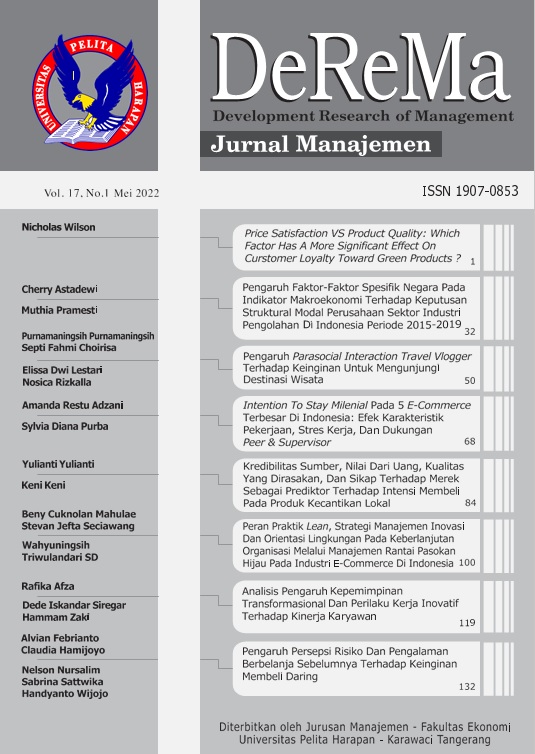PENGARUH FAKTOR-FAKTOR SPESIFIK NEGARA PADA INDIKATOR MAKROEKONOMI TERHADAP KEPUTUSAN STRUKTUR MODAL PERUSAHAAN SEKTOR INDUSTRI PENGOLAHAN DI INDONESIA PERIODE 2015-2019 [THE EFFECT OF COUNTRY SPECIFIC FACTORS ON MACROECONOMIC INDICATORS ON CAPITAL STRUCTURE DECISIONS OF THE PROCESSING INDUSTRY SECTOR COMPANIES IN INDONESIA 2015-2019 PERIOD]
DOI:
https://doi.org/10.19166/derema.v17i1.4569Trefwoorden:
Country-specific factors, macroeconomics, process manufacturing industry, Indonesia listed firms, panel data, capital structureSamenvatting
This research was conducted to investigate the influence of country-specific factors on macroeconomic indicators on capital structure decision of process manufacturing industry’s companies in Indonesia. This study used a sample of 45 public companies from process manufacturing industry in Indonesia within the period of 2015-2019. Using the balanced panel data regression, with the estimation technique of random effect model, the result of this study shows the country-specific factors which consist of prime lending rate, GDP growth, inflation rate, exchange rate, and corporate tax rate do not have any direct influence on the capital structure decision of firms, while the selected firm-specific variables such as profitability, tangibility and growth rate are significant determinants of capital structure decision from process manufacturing industry’s companies in Indonesia.
Bahasa Indonesia Abstrak: Penelitian ini bertujuan untuk mengetahui pengaruh faktor-faktor spesifik negara pada indikator makroekonomi terhadap keputusan struktur modal perusahaan sektor industri pengolahan di Indonesia. Penelitian ini menggunakan sampel sebanyak 45 perusahaan sektor industri pengolahan yang terdaftar di Bursa Efek Indonesia pada periode 2015-2019. Dengan menggunakan metode regresi balanced data panel dan teknik estimasi random effect model, hasil penelitian menunjukkan bahwa faktor-faktor spesifik negara pada indikator makroekonomi yang terdiri dari prime lending rate, pertumbuhan PDB, tingkat inflasi, exchange rate, dan corporate tax rate tidak memiliki pengaruh langsung terhadap keputusan struktur modal perusahaan, sedangkan variabel spesifik perusahaan yang dipilih yaitu profitabilitas, tangibility dan growth rate merupakan determinan yang signifikan dalam proses pengambilan keputusan struktur modal perusahaan sektor industri pengolahan di Indonesia.
Referenties
Akbar, R. (2018). The Optimal Allocation for Capital Preservation: an Evidence Australian Portfolio. DeReMa (Development Research of Management): Jurnal Manajemen, 13(1), 1. https://doi.org/10.19166/derema.v13i1.605
Allayannis, G., & Ofek, E. (2001). Exchange rate exposure, hedging, and the use of foreign currency derivatives. Journal of International Money and Finance, 20(2). https://doi.org/10.1016/S0261-5606(00)00050-4
Antoniou, A., Guney, Y., & Paudyal, K. N. (2005). Determinants of Corporate Capital Structure: Evidence from European Countries. SSRN Electronic Journal. https://doi.org/10.2139/ssrn.302833
Badan Pusat Statistik. (2020). Inflasi. Retrieved from https://www.bps.go.id/subject/3/inflasi.html
Badan Pusat Statistik. (2020). Produk Domestik Bruto (Lapangan Usaha). Retrieved from https://www.bps.go.id/subject/11/produk-domestik-bruto--lapangan-usaha-.html
Badan Pusat Statistik. (2020). Kurs Tengah Beberapa Mata Uang Asing Terhadap Rupiah di Bank Indonesia dan Harga Emas di Jakarta (rupiah), 2000-2019. Retrieved from https://www.bps.go.id/linkTableDinamis/view/id/952
Bancel, F., & Mittoo, U. R. (2004). Why do european firms issue convertible debt? European Financial Management, 10(2), 339-373. https://doi.org/10.1111/j.1354-7798.2004.00253.x
Bartov, E., & Bodnar, G. M. (1994). Firm Valuation, Earnings Expectations, and the Exchange”Rate Exposure Effect. The Journal of Finance, 49(5). https://doi.org/10.1111/j.1540-6261.1994.tb04780.x
Bas, T., Muradoglu, G., & Phylaktis, K. (2009). Determinants of Capital Structure in Developing Countries. Business.
Bokpin, A. G. (2009). Macroeconomic development and capital structure decisions of firms. Studies in Economics and Finance, 26(2), 129-142. https://doi.org/10.1108/10867370910963055
Booth, L., Aivazian, V., Demirguc-Kunt, A., & Maksimovic, V. (2001). Capital structures in developing countries. Journal of Finance. https://doi.org/10.1111/0022- 1082.00320
Brigham, E. F., & Houston, J. F. (2007). Fundamentals of financial management (Dasar-dasar Manajemen Keuangan). Engineering and Process Economics, 3.
Buvanendra, S., Sridharan, P., & Thiyagarajan, S. (2016). Role of country-specific factors on capital structure decision””evidence from Sri Lankan listed firms. Global Business Review, 17(3), 582-593. . https://doi.org/10.1177/0972150916630454
Caglayan, M., & Demir, F. (2014). Firm Productivity, Exchange Rate Movements, Sources of Finance, and Export Orientation. World Development, 54. https://doi.org/10.1016/j.worlddev.2013.08.012
Daskalakis, N., Balios, D., & Dalla, V. (2017). The behaviour of SMEs’ capital structure determinants in different macroeconomic states. Journal of Corporate Finance, 46. https://doi.org/10.1016/j.jcorpfin.2017.07.005
Demirgüç-Kunt, A., & Maksimovic, V. (1999). Institutions, financial markets, and firm debt maturity. Journal of Financial Economics, 54(3), 295-336. https://doi.org/10.1016/S0304- 405X(99)00039-2
Desai, M. A., Foley, C. F., & Hines, J. R. (2004). A Multinational Perspective on Capital Structure Choice and Internal Capital Markets. Journal of Finance, 59(6), 2451-2487.
Dias Basto, D., Nakamura, W. T., & Basso, L. C. (2011). Determinants of Capital Structure of Publicly-Traded Companies in Latin America: The Role of Institutional and Macroeconomics Factors. SSRN Electronic Journal. https://doi.org/10.2139/ssrn.1365987
Dincergok, B. and K. Yalciner (2011) Capital Structure Decisions of Manufacturing Firms’ in Developing Countries. Middle Eastern Finance and Economics, 86-100.
Drobetz and Fix. (2003). What are the determinants of the capital structure? Some evidence for Switzerland. WWZ/Department of Finance, Working Paper No. 4/03, 4(3).
Faccio, M., & Xu, J. (2015). Taxes and Capital Structure. Journal of Financial and Quantitative Analysis, 50(3). https://doi.org/10.1017/S0022109015000174
Fanelli, J. M. and S. Keifman (2002): Finance and changing trade patterns in developing countries, in J. M. Fanelli and R. Medhora (Eds.). Finance and Competitiveness in Developing Countries. London, Routledge.
Frank, M. Z., & Goyal, V. K. (2009). Capital structure decisions: Which factors are reliably important?. Financial Management, 38(1). https://doi.org/10.1111/j.1755- 053X.2009.01026.x
Gajurel, D. P. (2011). Macroeconomic Influences on Corporate Capital Structure. SSRN Electronic Journal. https://doi.org/10.2139/ssrn.899049
Gaud, P., Jani, E., Hoesli, M., & Bender, A. (2005). The capital structure of swiss companies: An empirical analysis using dynamic panel data. European Financial Management, 11(1). https://doi.org/10.1111/j.1354-7798.2005.00275.x
Giannetti, M. (2003). Do Better Institutions Mitigate Agency Problems? Evidence from Corporate Finance Choices. The Journal of Financial and Quantitative Analysis, 38(1). https://doi.org/10.2307/4126769
Goyal, V. K., & Packer, F. (2017). Capital structure in emerging Asia (HKUST IEMS Working Paper Series 2017-48). HKUST Institute for Emerging Market Studies.
Graham, J. R. (2000). How big are the tax benefits of debt?. Journal of Finance, 55(5), 1901-1941. https://doi.org/10.1111/0022-1082.00277
Graham, J. R., Hanlon, M., Shevlin, T., & Shroff, N. (2014). Incentives for Tax Planning and Avoidance: Evidence from the field. Accounting Review, 89(3). https://doi.org/10.2308/accr-50678
Grossman, S. J. and Hart, O. D. (1982). Corporate Financial Structure and Managerial Incentives. The Economics of Information and Uncertainty. McCall, J.J. (Ed.). University of Chicago Press.
Gujarati, D. N. (2004). Basic Econometrics (4th ed.). Tata McGraw-Hill.
Hanousek, J., & Shamshur, A. (2011). A stubborn persistence: Is the stability of leverage ratios determined by the stability of the economy?. Journal of Corporate Finance, 17(5), 1360-1376. https://doi.org/10.1016/j.jcorpfin.2011.07.004
Harris, M., & Raviv, A. (1991). The Theory of Capital Structure. The Journal of Finance, 46(1), 297-355. https://doi.org/10.1111/j.1540-6261.1991.tb03753.x
Hatzinikolaou, D., Katsimbris, G. M., & Noulas, A. G. (2002). Inflation uncertainty and capital structure. Evidence from a pooled sample of the Dow-Jones industrial firms. International Review of Economics and Finance, 11(1). https://doi.org/10.1016/S1059-0560(01)00085-5
Haugen, R. A., & Senbet, L. W. (1986). Corporate Finance and Taxes: A Review. Financial.
Jensen, M. C. (1986). Agency Costs of Free Cash Flow, Corporate Finance, and Takeovers Agency Costs of Free Cash Flow, Corporate Finance, and Takeovers. American Economic Review, 76(2). https://doi.org/10.2139/ssrn.99580
Jõeveer, K. (2013). Firm, country and macroeconomic determinants of capital structure: Evidence from transition economies. Journal of Comparative Economics, 41(1). https://doi.org/10.1016/j.jce.2012.05.001
KarpaviÄius, S., & Yu, F. (2017). The impact of interest rates on firms’ financing policies. Journal of Corporate Finance, 45. https://doi.org/10.1016/j.jcorpfin.2017.05.007
Kraus, A., & Litzenberger, R. H. (1973). A State”Preference Model of Optimal Financial Leverage. The Journal of Finance, 28(4). https://doi.org/10.1111/j.1540- 6261.1973.tb01415.x
Kumar, S., Colombage, S. and Rao, P. (2017), "Research on capital structure determinants: a review and future directions". International Journal of Managerial Finance, 13 (2), 106-132. https://doi.org/10.1108/IJMF-09-2014-0135
Michaelas, N., Chittenden, F., & Poutziouris, P. (1999). Financial Policy and Capital Structure Choice in U.K. SMEs: Empirical Evidence from Company Panel Data. Small Business Economics, 12(2). https://doi.org/10.1023/A:1008010724051
Modigliani, F., & Miller, M. H. (1958). The cost of capital, corporation finance and theory of investment. Journal of Craniomandibular Disorders: Facial & Oral Pain.
Modigliani, F., & Miller, M. H. (1963). Corporate Income Taxes and the Cost of Capital: A Correction. American Economic Review, 53(3). https://doi.org/10.2307/1809167
Mokhova, N., & Zinecker, M. (2014). Macroeconomic Factors and Corporate Capital Structure. Procedia - Social and Behavioral Sciences, 110. https://doi.org/10.1016/j.sbspro.2013.12.897
Myers, S. C. (2001). Capital structure. Journal of Economic Perspectives. https://doi.org/10.1257/jep.15.2.81
Myers, S. C., & Majluf, N. S. (1984). Corporate financing and investment decisions when firms have information that investors do not have. Journal of Financial Economics. https://doi.org/10.1016/0304-405X(84)90023-0
Naudé W., Szirmai, A. The importance of manufacturing in economic development: Past, present and future perspectives. UNU-MERIT Working Papers, 2012-041, 2012.
Otoritas Jasa Keuangan. (2020). Prime Lending Rate. Retrieved from https://www.ojk.go.id/en/kanal/perbankan/Pages/Suku-Bunga- Dasar-Kredit.aspx
Ozkan, A. (2001). Determinants of capital structure and adjustment to long run target: Evidence from UK company panel data. Journal of Business Finance and Accounting, 28(1-2). https://doi.org/10.1111/1468-5957.00370
Öztekin, Ö. (2015). Capital Structure Decisions around the World: Which Factors Are Reliably Important?. Journal of Financial and Quantitative Analysis, 50(3). https://doi.org/10.1017/S0022109014000660
Schall, L. D. (1984). Taxes, Inflation and Corporate Financial Policy. The Journal of Finance, 39(1). https://doi.org/10.1111/j.1540-6261.1984.tb03863.x
Stulz, R. M. (1990). Managerial discretion and optimal financing policies. Journal of Financial Economics, 26(1). https://doi.org/10.1016/0304-405X(90)90011-N
Titman, S., & Wessels, R. (1988). The Determinants of Capital Structure Choice. The Journal of Finance, 43(1), 1-19. https://doi.org/10.1111/j.1540-6261.1988.tb02585.x
Vo, X. (2017). Determinants of capital structure in emerging markets: Evidence from Vietnam. Research in International Business and Finance, 40, 105-113. https://doi.org/10.1016/j.ribaf.2016.12.001
##submission.downloads##
Gepubliceerd
Nummer
Sectie
Licentie
Authors who publish with this journal agree to the following terms:
1) Authors retain copyright and grant the journal right of first publication with the work simultaneously licensed under a Creative Commons Attribution License (CC-BY-SA 4.0) that allows others to share the work with an acknowledgement of the work's authorship and initial publication in this journal.
2) Authors are able to enter into separate, additional contractual arrangements for the non-exclusive distribution of the journal's published version of the work (e.g., post it to an institutional repository or publish it in a book), with an acknowledgement of its initial publication in this journal.
3) Authors are permitted and encouraged to post their work online (e.g., in institutional repositories or on their website). The final published PDF should be used and bibliographic details that credit the publication in this journal should be included.





